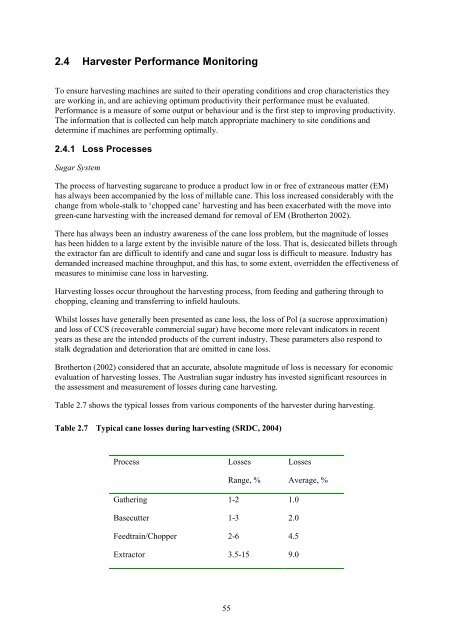Download (4Mb) - USQ ePrints - University of Southern Queensland
Download (4Mb) - USQ ePrints - University of Southern Queensland
Download (4Mb) - USQ ePrints - University of Southern Queensland
You also want an ePaper? Increase the reach of your titles
YUMPU automatically turns print PDFs into web optimized ePapers that Google loves.
2.4 Harvester Performance Monitoring<br />
To ensure harvesting machines are suited to their operating conditions and crop characteristics they<br />
are working in, and are achieving optimum productivity their performance must be evaluated.<br />
Performance is a measure <strong>of</strong> some output or behaviour and is the first step to improving productivity.<br />
The information that is collected can help match appropriate machinery to site conditions and<br />
determine if machines are performing optimally.<br />
2.4.1 Loss Processes<br />
Sugar System<br />
The process <strong>of</strong> harvesting sugarcane to produce a product low in or free <strong>of</strong> extraneous matter (EM)<br />
has always been accompanied by the loss <strong>of</strong> millable cane. This loss increased considerably with the<br />
change from whole-stalk to ‘chopped cane’ harvesting and has been exacerbated with the move into<br />
green-cane harvesting with the increased demand for removal <strong>of</strong> EM (Brotherton 2002).<br />
There has always been an industry awareness <strong>of</strong> the cane loss problem, but the magnitude <strong>of</strong> losses<br />
has been hidden to a large extent by the invisible nature <strong>of</strong> the loss. That is, desiccated billets through<br />
the extractor fan are difficult to identify and cane and sugar loss is difficult to measure. Industry has<br />
demanded increased machine throughput, and this has, to some extent, overridden the effectiveness <strong>of</strong><br />
measures to minimise cane loss in harvesting.<br />
Harvesting losses occur throughout the harvesting process, from feeding and gathering through to<br />
chopping, cleaning and transferring to infield haulouts.<br />
Whilst losses have generally been presented as cane loss, the loss <strong>of</strong> Pol (a sucrose approximation)<br />
and loss <strong>of</strong> CCS (recoverable commercial sugar) have become more relevant indicators in recent<br />
years as these are the intended products <strong>of</strong> the current industry. These parameters also respond to<br />
stalk degradation and deterioration that are omitted in cane loss.<br />
Brotherton (2002) considered that an accurate, absolute magnitude <strong>of</strong> loss is necessary for economic<br />
evaluation <strong>of</strong> harvesting losses. The Australian sugar industry has invested significant resources in<br />
the assessment and measurement <strong>of</strong> losses during cane harvesting.<br />
Table 2.7 shows the typical losses from various components <strong>of</strong> the harvester during harvesting.<br />
Table 2.7 Typical cane losses during harvesting (SRDC, 2004)<br />
Process Losses Losses<br />
Range, % Average, %<br />
Gathering 1-2 1.0<br />
Basecutter 1-3 2.0<br />
Feedtrain/Chopper 2-6 4.5<br />
Extractor 3.5-15 9.0<br />
55
















